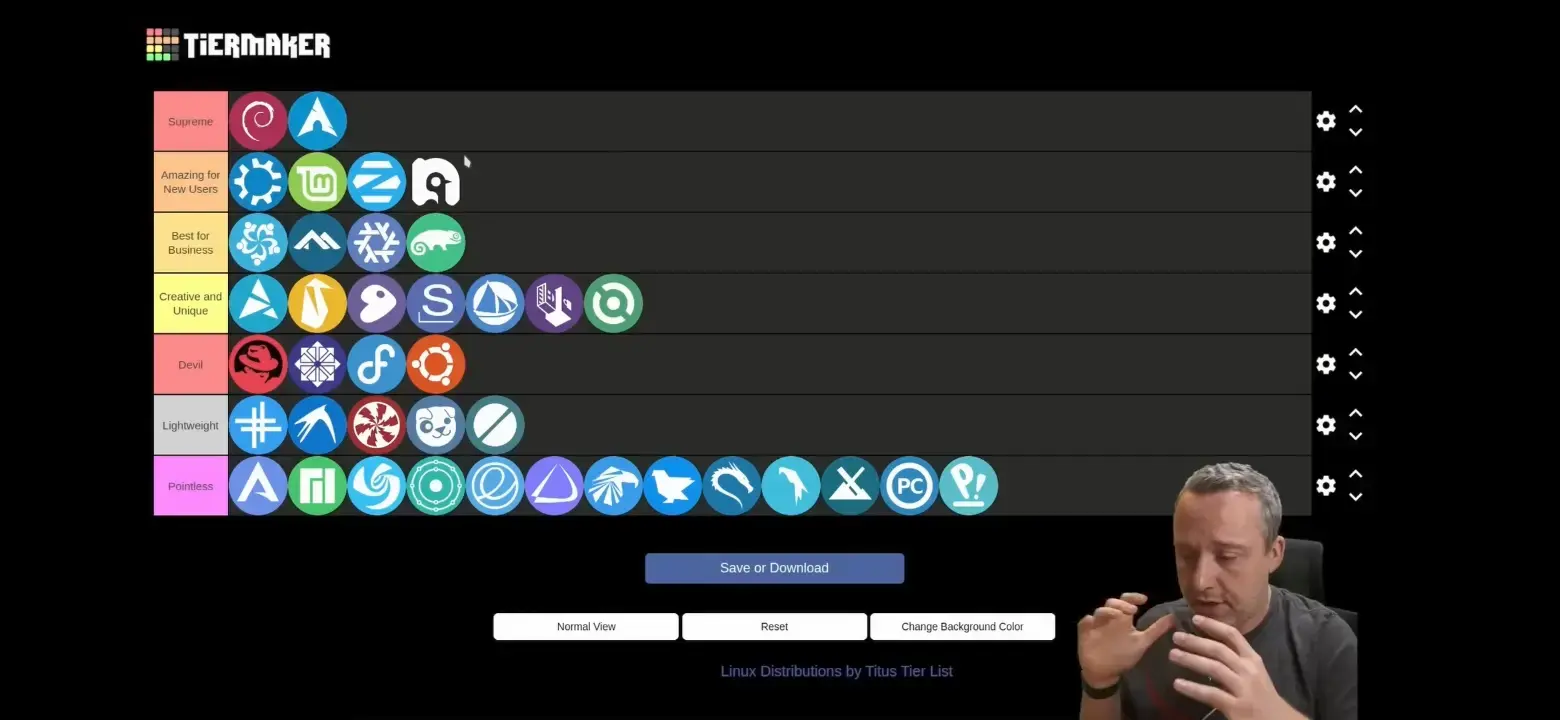Since i see so much linux talk on lemmy i got curious and watched a video about the common distros. How true is the information in this video? The person hardly describes why debian and arch are just better than every other distro. At least i’m definitely now curious about Mint or something for gaming.
- when this was originally posted, it got a lot of flack because Linux users were unhappy Chris Titus dares to use both Linux AND Windows
- as @bbbhitz pointed out, “Pointless” was probably a poor choice of words, but Chris’ definition for that tier was basically “distros that install a couple stock packages and give it a new name”
- as for the Devil tier
- RedHat for closing their source
- CentOS Stream because it’s not CentOS
- Fedora guilt by association (they are actually a separate entity from their founder RedHat)
- Ubuntu because snaps
- for Debian and Arch, not only are they good distros on their own, but they’ve each also become parents (and grandparents) to a huge number of offshoots
- for gaming
- for beginners, Linux Mint is a really popular place to start just in general
- for the more experienced, options like Nobara or customizing SteamOS
as a noob, why are snaps so bad? Thanks for the bullet points btw, it cleared a bunch of stuff up :)
Again this? lol
literally never saw this posted here so @cerement@slrpnk.net is right
While I find that I agree with his takes like, 55% of the time, I do agree that Debian and Arch are basically the S-tier distros. So many of the other ones are basically just opinionated Debian or Arch, and while those can be useful when you’re getting started, I’ve found that for the long haul you’re better off just figuring out how to configure the base distribution with the elements of the opinionated ones that you like rather than use those distros themselves. Also, RIP CentOS. I would have put that in a high tier before the RHELmageddon (not top tier mind you, but it had a well defined use case and was great for that purpose).
Ah ok i gues si can understand it makes sense that if you really wanna learn linux you gotta be ready to get your hands dirty aka figuring out how to configure the distribution. Maybe its just very overwhelming because a beginner doesnt even know what you can / can’t configure. But probably everything

Don’t like that he called some distros pointless. I would have found a better word. Lots on there that I have never used, obviously, because I am not a sadist. I couldn’t tell you what would be good for gaming or not, but flatpaks have made some things easier (or so I’ve heard, don’t quote me on that). And Fedora is a “Devil?”
Anyway. While I don’t watch this channel ever, I am aware of it as a reputable channel for things like this, so it might be trustworthy.
Why are Debian and Arch at the top? Debian is one of the grandaddies. Many distros are built on Debian—MX, Mint, Ubunu, Pop, Zorin, Neon, etc.—and there are many packages in the repos, which are divided into stable, and testing, and unstable sections. So, a Debian base can be stable or extremely up to date. The Debian community and maintainers are another reason the distro is so well-liked. Arch also has a large selection of packages, an excellent wiki, and the AUR to have access to anything missing from regular repos. Manjaro and dozens of others are based on Arch as well, meaning the community is rather large.
No need to follow rules and conventions though. There are many people, myself included, that use Alpine for their desktop because the packages are very up to date.
Interesting that you said Arch has a good wiki. Maybe its just because its not common for beginners to start with Arch but when i read through the installation guide i noticed that there is no explanation on how to create a bootable usb in windows, at least the part for how to verify the signature wasnt explained for a windows user. For Linux Mint it was pretty much at the top, how to create a bootable usb in windows. I was very suprised that this guy called fedora and ubuntu the “devil” when i saw many people here use fedora.
One question though, you talked about packages and how they are sometimes different. How much had the amount of options for packages an effect on you, or anyone, while choosing your distro?
The video is clickbait and a few of the distros are in categories just for dramatic effect. I personally share Chris’s criteria for “pointless” distros however, and I hope that his main “clickbait motive” was trying to stop people from hopping around from gimmick distro to gimmick distro when the real magic has always been with the Debian/Arch base underneath the hood. I don’t care to give Chris the attention he wants so I’d rather answer your questions instead of talk about the video directly:
I agree that Debian and Arch are “S-tier” distros. Not that they’re better than everything else for every usecase but they are very high quality community-run distros with large package bases, and they accomplish their mission statements with ease. If you’re a Linux power user for long enough you may eventually settle into one of these two distros because they give you a lot of room to mold your configuration without being opinionated by downstream distro maintainers.
Linux Mint is very good, and it’s probably the only “fork distro” that I recommend people use because it makes Debian/Ubuntu very simple and usable for new users, and it’s done so for many years with a great track record. I currently run Debian Stable but if you put a gun to my head and said “you can only run Linux Mint from now on” I’d be fine with it. Specifically, I prefer the LMDE edition but the normal version is good too.
You can run cutting-edge gaming stuff on Debian Stable and Linux Mint by using Flatpak Lutris/Steam, which uses its own cutting-edge Mesa package instead of the system’s, and you can also install a cutting-edge kernel on these stable distros by using Debian backports or e.g. XanMod. I prefer using stable distros like Debian Stable and pulling cutting-edge versions of your important packages through Flatpak or other means, which gives you a “stable base and rolling top”.
I think the general usecase for Arch has diminished from half a decade ago due to Flatpak’s popularity, and IMO a stable base setup makes more sense if you can get everything important that you need from Flatpaks. With Arch, not only are the programs you care about bleeding-edge, everything is bleeding-edge, and you may end up with annoying bugs from packages you didn’t even know existed.
If you want a more modern version of the Linux desktop without the bleeding-edge of Arch I think OpenSUSE Tumbleweed is a great cutting-edge distro. They have extensive automatic testing that ensures high system stability even while living near the edge of package freshness. The main downside is OpenSUSE’s smaller package base compared to Debian/Arch-based distros.
thanks for the explanations. I only used Ubuntu like 5 years ago and since then never again. From what i understand flatpak is a linux command to install applications. Ubuntu uses apt / apt-get (whatever the difference is there). Why does this guy shit on apt so much? I dont know whats wrong with it and why is flatpak so good?
It’s just clickbait like most of his videos, I never really liked Chriss’ videos, the tip of the iceberg was when he told people to disable kernel mitigation for a presumable performance boost (I tested it with disconnected network, it was like 2% on my machine), which is just plain dumb.
Use whatever distro you like, just know that you don’t have to distrohop for some program (DE or WM or whatever). I personally use endeavour, simply because I’ve used arch (and derivatives) for a while now and endeavour is just arch with sensible defaults and a lot of the configuration one would do anyway already done.
yeah i guess this one didnt scream clickbait as much as the other videos of his. I got some in my feed afterwards and quickly realised that this guy doesnt shy away from using clickbait titles.
What is DE or WM? Is it actually that easy to change distro? Dont you have to basically install everything again from scratch? I read somewhere that you can seperate your directories on your SSD so that you can just change the kernel but i dont know how easy or true that is
DE is desktop environment (like gnome, kde, xfce,…) And WM is window manager (like i3, sway, xmonad,…) Which is just a slim version of a de, they usually don’t include things like guis for settings, file managers, … and you just pick what you like and use that. The window manager is responsible for placing the windows in your workspace and most standalone wms are tiling, so they use your monitor space efficiently instead of putting floating windows all over the place. Basically the DE (or WM) is what you interact with most on your PC and a lot of beginners distrohop just to use a different DE when in reality you can just install the other de on your existing system, log out and select the new DE in your login screen.
The biggest differences between distros nowadays are their release cycles and their package managers (and the tepos they’re using, like Ubuntu and Debian both use apt, but have separate repos)
And no you can’t really change distro without reinstalling, you can change kernels tho, every distro will update their kernels from time to time and it’s just a matter of install the new package and reboot into the new kernel.
With separate directories you probably mean partitions, which I’d also say it’s advisable to have your /home partition separated from your / partition. That way if you ever have to reinstall or want to change distro you can just install into the root partition and afterwards add your old/home partition to /etc/fstab and keep all you’re user data and configuration
interesting, so every DE has a WM or are can only one of them at a time be used? And if you use a WM you have to install guis, file managers yourself? I think the only thing i would want is a DE/WM that has tabs for folders. I think its a neat feature to have
The basic GUI experience in X is provided by the window manager. It controls how your windows are placed ( eg. Tiling vs Stacking / Floating ), how they are decorated ( eg. Max / Min / Close buttons ), and how they behave ( eg. Click to focus ). In X, the window manager runs as an application on the X server. You can only use one at a time.
In Wayland, the “window manager” is the display-server too and is called a compositor. For smaller projects, there are compositor libraries that provide similar capabilities to what the X server did so that these projects can concentrate on the “window manager” part. You can think of a Wayland compositor as equivalent to an X window manager ).
A Desktop Environment comes with a window manager ( or compositor ) and adds other tools that run alongside ( or on top of ) the window manager to provide a full user experience. This may include panels ( eg. think Windows start button, icon bar, and status tray ), docks ( like MacOS ), global menus, notification applets, and the desktop surface itself ( eg. are there icons or other features on the desktop ). A DE usually comes with a standard set of basic applications like a file manager, image viewer, document viewer, media player, and the like.
If you start with a basic window manager then yes you have to add all this other stuff yourself. Of course you may not want some of it and so can have a much lighter experience. You can also just choose tools that you like. Of course, they may not match visually or work perfectly together.
If you use a DE, the experience is curated for you and everything is more likely to work well out of the box. That said, nothing stops you from swapping out whatever components you want. You can even use a different window manager than the DE default.
Thanks alot for the more than enough explanation :)






